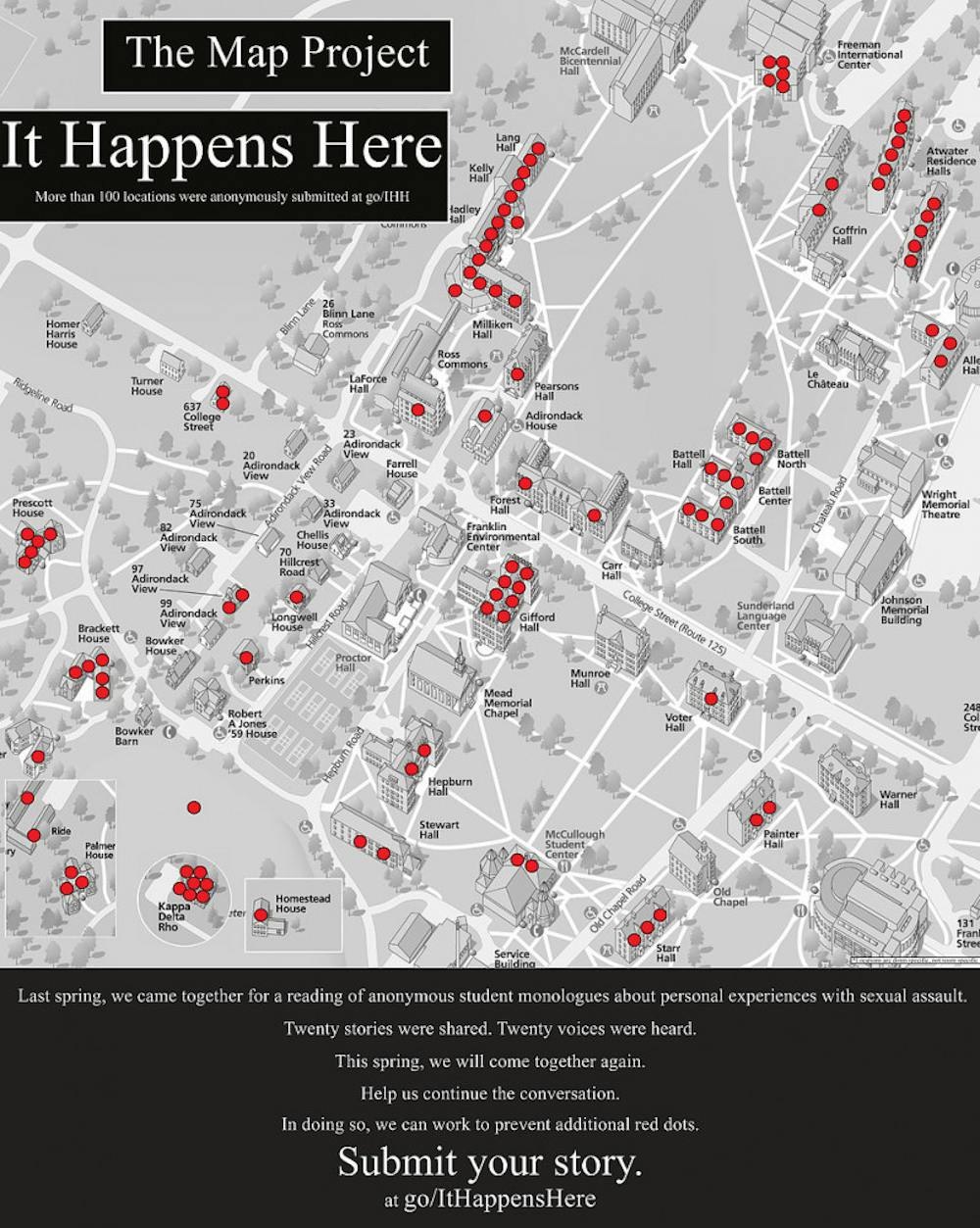Signs reading “go/mapproject” appeared across campus last week, advertising a link that leads to a form where respondents can identify where they have been sexually assaulted on campus.
The goal of the project is to visualize locations where sexual violence has occured on campus. It Happens Here (IHH) began the map project in 2012, placing a map with red dots paired with a selection of anonymous stories on display in the atrium of Davis Family Library.
Taite Shomo ’20.5, one of the organizers of IHH, led the effort to revive the map project this year.
“The reason we decided to bring the map project back now is because of all of the student activism on campus, as well as the activism around the country about sexual assault,” Shomo said. “I’ve also been looking for ways to make IHH larger than just a once-a-semester event, and this was one way to continue to raise awareness about sexual assault at Middlebury aside from the regular events.”
The map project reflects the reality that sexual assault remains a major problem at Middlebury. This reality is what drove the protest that took place at the Pather Day parade against Middlebury’s handling of sexual assault. One of the protestors at the Panther Day protest was holding the 2013 map.
“The map is powerful because it gives people a visual of how pervasive and prevalent sexual assault and harassment are on this campus,” Shomo said. Recent campus security reports have recorded no more than 25 reported instances of sexual violence per year — a figure that IHH organizers believe is in fact much higher.
[pullquote speaker="Taite Shomo '20.5" photo="" align="center" background="on" border="all" shadow="on"]The map is powerful because it gives people a visual of how pervasive and prevalent sexual assault and harassment are on this campus.[/pullquote]
“The objective is to get people to consider how much of a reality assault and harassment are here,” Shomo explained.
Annie Blalock ’20.5, president of Feminist Action at Middlebury (FAM), echoed the same sentiment.
“There’s that one story that you have in your head that you saw on the news, and then looking at a map like that, you think ‘that’s this one red dot here’ and then you’re like ‘oh, there’s hundreds of red dots, every one of those is a story like that,” Blalock said.
Although she is not involved with organizing the map project, Blalock is an enthusiastic supporter. IHH and FAM engage with many overlapping issues.
“There’s an obvious tie between feminism and raising awareness of sexual assault and holding perpetrators accountable,” Blalock said. “We are now living a culture where people who formerly were silenced by our society and the systems in place that silenced victims, are being given the space to speak out.”
In the original map project, which was completed in early 2013, most submitted sexual assaults occurred in party hotspots such as Atwater, social houses, KDR and Palmer, as well as other residence halls, especially underclassmen dorms. However, sexual violence can happen anywhere, as victims reported incidents in both the McCullough Student Center and the Freeman International Center as well.
[pullquote speaker="Annie Black '20.5" photo="" align="center" background="on" border="all" shadow="on"]Walking through a place like Allen and being like, ‘Someone was assaulted here.’[/pullquote]
“I think it’s an interesting perspective to gain,” said Blalock, reflecting on the benefit of locating the the incidents of sexual violence on a map. “Walking through a place like Allen and being like, ‘Someone was assaulted here.’”
According to Shomo, the map from this year will be formatted in the same manner as the previous map. However, Shomo added that organizers may need to make the map bigger because they are accepting reports of both sexual assault and harassment, whereas the 2013 map only dealt with sexual assaults.
“I would be surprised if we see any of the campus on the map, as opposed to it just being all red dots,” Blalock said.

The 2013 Map Project details sexual assault at locations on campus.
The go/mapproject survey contains two questions. The first asks in which residence halls respondents have experienced sexual assault or harassment. The second asks in which other buildings, including dining halls and academic buildings, respondents have experienced sexual assault or harassment.
“Filling out that form itself could be empowering for people because they feel involved,” Blalock said.
She also believed that some people would still not feel comfortable submitting the form, although it is anonymous.
“Even with all the reports that this map project gets, it’s not going to be the whole number of assaults or reports of harassment.”
Between 2013 and 2015, some members of the college community were concerned that IHH’s events and advertising were triggering to students. Others were worried that the map project would stigmatize certain buildings on campus, but Shomo was not concerned about this.
“I think that the maps will show that sexual violence happens in so many of the buildings on campus that I’m not concerned about it sending a message that assault only happens in some spaces,” Shomo said.
In a 2013 Campus article on the map project, Luke Carrol-Brown ’13 responded to the criticism that the project stigmatized certain locations on campus.
“The Map Project has never been about identifying danger zones on campus,” he said. “That would stink of emphasizing victim responsibility instead of placing accountability where it should lie: in the hands of the individuals who perpetrate these crimes. The Map Project is about coming clean with a problem that so many of us deny or disregard, putting the human impact of this epidemic in visual form and driving empathy amongst survivors.”
[pullquote speaker="Luke Carrol-Brown '13" photo="" align="center" background="on" border="all" shadow="on"]The Map Project has never been about identifying danger zones on campus.[/pullquote]
In January 2014, The Campus published an editorial titled “It Happens Here: It’s Time to Evolve.” In it, the editorial board argued that the map, IHH events and signs reading “It Happens Here” could be powerful triggers that hurt survivors, and urges them to adjust their strategies.
Student organizers of IHH published an op-ed in January 2015 addressing the conversation surrounding the potential triggering effect of their work. They acknowledged that though “these criticisms weigh heavily in our minds,” “there must be spaces for survivors to share their stories if/when they’re ready,” and that “if we are to continue to hold these events, we will continue to need to advertise. In our minds, relegating survivors’ experiences to the margins of this campus has never been and will never be an option.
“We raise consciousness that It Happens Here in the hope that one day, It won’t.”
Blalock was concerned about the lack of institutional support for survivors of sexual violence at Middlebury, but saw the Map Project as a resource for students.
“This is as much a tool for survivors and victims of assault or violence or harassment because it could be cathartic, it could be building that community, it could be feeling like a part of something or feeling not alone, but I think it’s as much a resource for survivors and victims as it is for bystanders or people who have not had a situation like that,” Blalock said. “One survivor is not alone, they are one of many people that have been victims of perpetrated violence.”
The submission form will remain open until Nov. 16.




